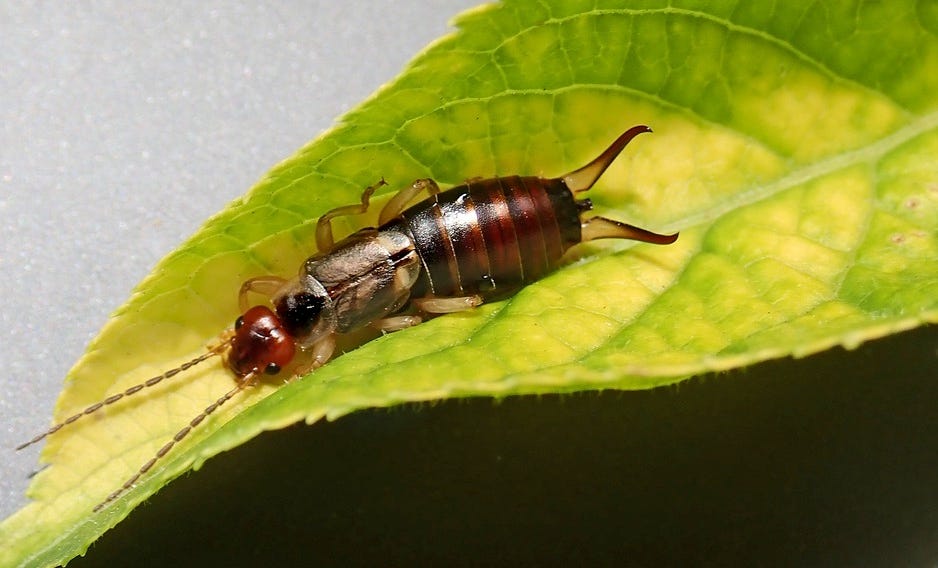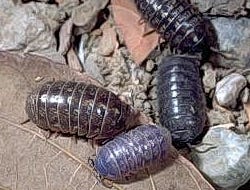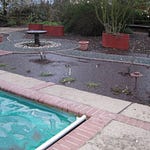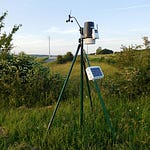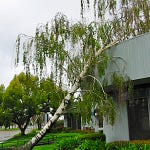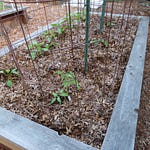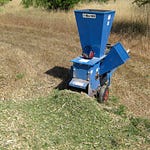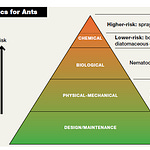In today’s newsletter podcast, our America’s Favorite Retired College Horticulture Professor, Debbie Flower, talks about earwigs, a garden scavenger that probably does more damage than you might want a “neutral” garden critter to do. Probably the most famous “neutral” garden insect is the non-selective praying mantis, who doesn’t mind chowing down on your aphids for dinner, with a ladybug for dessert. The big takeaway from that earwig chat? “Don't wear loose clothing in an earwig infested garden.” We also touch on (in a manner of speaking) roly polys (aka, pillbugs).
This Week on the Garden Basics Podcast
Before we delve into the answer to that question posed in the headline, here is what is going on in the Garden Basics with Farmer Fred podcast this week:
Tuesday, May 14: Episode 334 Q&A Rhubarb for Hot Climates? Lights for Seedlings?
In this episode, we answer garden questions from listeners. The first question is about growing rhubarb in hot weather. Master Gardeners Ruth Ostroff and Kathy Morrison (of the Sacramento Digs Gardening newsletter) discuss their experiences with growing rhubarb in Sacramento, which is challenging in a hot climate. (Ruth also names the rhubarb variety she has had success with in the hot Sacramento Valley.) Kathy shares a rhubarb recipe, made as an upside-down cake.
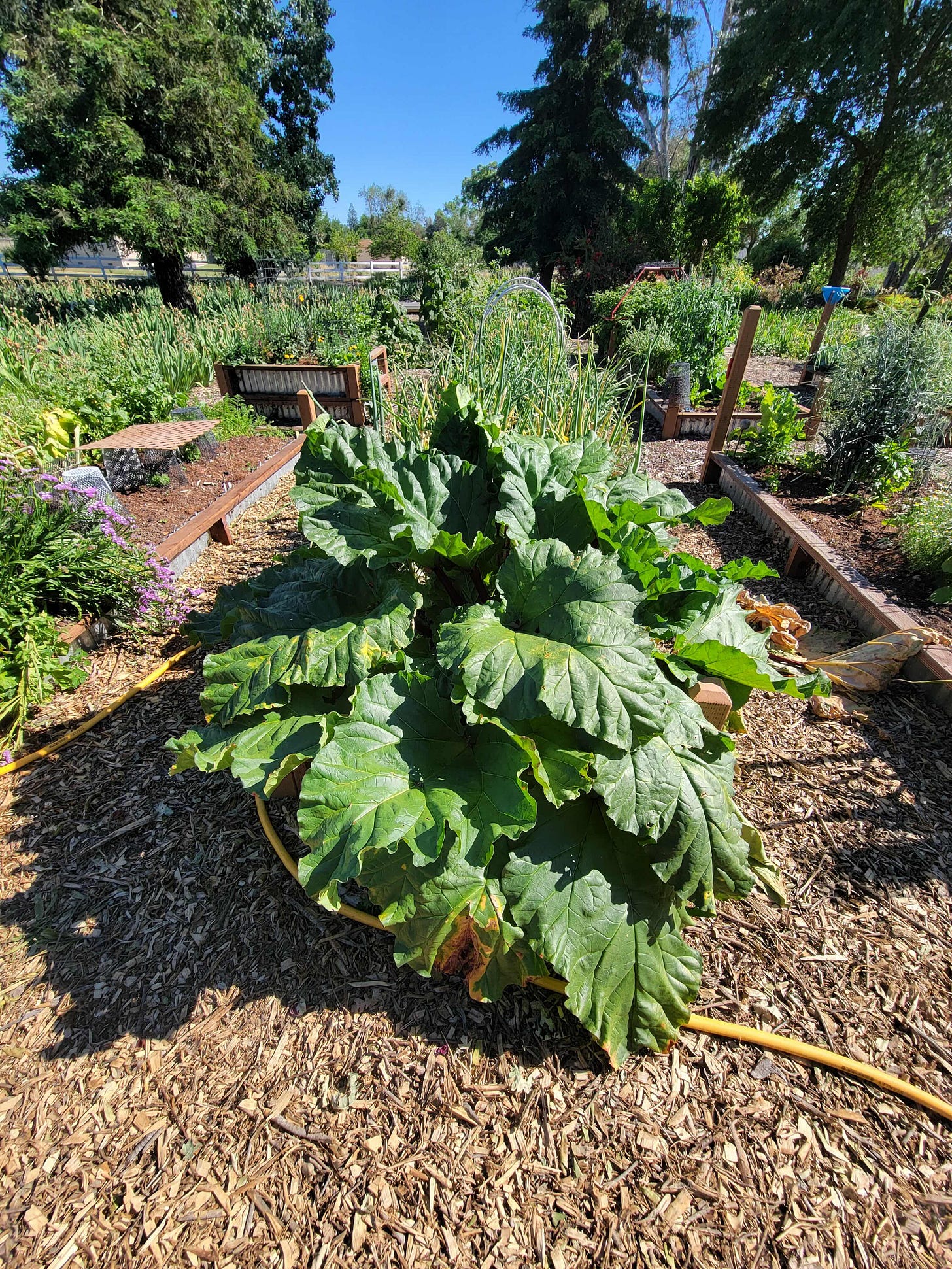
The second question is about grow lights for starting tomato and pepper seeds indoors. Debbie Flower and I explain the importance of using a light system that is big enough to cover all the seedlings equally, as well as mixing different bulb spectrum colors. Of course, Debbie also emphasizes the need for air circulation and movement for young plants. We’re old, so we recommend using fluorescent lights, but we discuss the different options available in the market.
Friday, May 17: Ep. 335 Roof Rat Control Tips. Asparagus-Lemon Recipes
In this episode of the Garden Basics with Farmer Fred podcast, the main topic of discussion with retired UC Cooperative Extension Farm Advisor Rachael Long is roof rats and their impact on gardens and orchards. The conversation covers the behavior and habits of roof rats, their diet, nesting habits, and the damage they can cause to fruit trees. The episode also includes tips for controlling roof rats, such as trapping and using bait stations. Additionally, the episode features a segment on recipes using garden fresh asparagus and lemons, with Master Food Preserver Myrna Undajon-Haskell.
Takeaways:
• Roof rats are nocturnal creatures that can cause significant damage to fruit trees and orchards.
• They have a preference for heights and are known to nest in attics and burrow underground.
• Roof rats can be controlled through trapping and the use of bait stations.
• Recipes using garden fresh asparagus and lemons are provided.
• Preserving lemons and dehydrating citrus are also discussed.

So, Who is Eating Your Seedlings? Controlling Sowbugs, Pillbugs and Earwigs in the Garden…and Indoors
From the garden e-mail bag, Jessica wants to know:
“I have a crazy amount of roly-polys and pincher bugs this year. And the pincher bugs keep making their way into my house, too. Help! Is there anything I can do to drive them away other than bug spray? And can the roly-polys cause damage to my plants? I normally don't have a green thumb but my plants are doing great this year and I'm finally feeling like a good ‘plant mom’ so I don't want anything to mess them up.”
Jessica, generally roly-polys (pillbugs) and sowbugs cause few issues with thriving plants. They prefer the dead organic matter on the ground. But if their favorite foods aren’t around, they will go after your plants.
According to the creepy, crawly experts at the UC Integrated Pest Management Department, sowbugs and pillbugs feed primarily on decaying plant material and are important decomposers of organic matter. However, they occasionally feed on seedlings, new roots, lower leaves, and fruits or vegetables touching the soil. They sometimes come indoors, which can be nuisance.
If pillbugs or sowbugs are a problem, reduce the amount of decaying organic matter on the soil and minimize the wetness of the soil surface. Irrigate early in the day so surfaces are drier by evening. Keep compost and mulch back from plants and building foundations to keep them outdoors. Using raised beds or planting boxes and drip or furrow irrigation instead of sprinklers usually keeps pillbugs and sowbugs from becoming serious problems.
Pincher bugs (earwigs) are also a mixed blessing. They will munch on garden plants, but they also eat aphids!
Despite their ferocious appearance, earwigs generally don’t attack humans, although they are capable of biting if trapped in clothing or sat upon.
Should you be concerned about earwigs in your garden? Yes, and no. If your yard is primarily lawn, trees, woody ornamentals or native plants, let the earwigs do their job, going after aphids.
However, if you are growing vegetables, herbaceous flowering plants, sweet corn or plants with soft fruits such as strawberries or apricots…yes, take action. Earwigs feed at night and hide during the day in dark, cool, moist places in the yard as well as within flowers and vegetables. Your job is to reduce their hiding places and surrounding moist areas, as well as employing vigilant trapping.
Some tips for earwig control from the UC Integrated Pest Management Program:
• Eliminate dense undergrowth of vines, ground cover, and weeds around vegetable and flower gardens.
• Clear weeds away from the base of fruit trees and prune out any fruit tree suckers near the ground that earwigs could use as a ladder. Harvest fruit as soon as it’s ready. Pick up any fallen fruit.
• Remove leaves, boards, boxes, and other debris from the planting areas.
• Move flowerpots and other garden objects that can harbor earwigs.
• Reduce moisture in the area. Use drip irrigation instead of sprinklers.
Indoors, earwigs can be swept or vacuumed up. If earwigs are a regular problem in a building, inspect the area to see how they are getting into the house and seal up cracks and entry points. Remove materials outside the perimeter of the building that could provide hiding places, such as ivy growing up walls, ground cover, bark mulches, debris (especially leaves in gutters), wood piles, leaf litter, piles of newspapers, or other organic matter.
Also, keep water and moisture away from the structure by repairing drain spouts. Grade the area so water drains away from the structure.
Pillbug and Sowbug Fun Facts!
(courtesy of Butte Co. (CA) Master Gardener Michelle Ramsey)
• It’s hard to believe, but sowbugs and pillbugs are more closely related to lobsters and crayfish than they are to insects. These soil-dwelling crustaceans belong to the Isopoda order.
• Because they are crustaceans they breathe through plate-like gills located on the underside of the abdomen.
• These bugs are the only crustaceans that have adapted to living their entire life on land.
• Sowbugs and pillbugs are similar in appearance and their names are sometimes used interchangeably.
• However, the sowbug has a pair of tail-like appendages which project out from the rear of its body.
• The pillbug has no extreme posterior appendages, and can roll up into a tight ball when disturbed. This is why pillbugs are sometimes called “Roly-Poly” bugs
• Females have marsupial-like pouches on the undersides of their bodies that can hold up to 100 developing eggs.
• The immature isopod can remain in the pouch for up to 2 months after hatching.
• Full development to an adult takes about 1 year. During this time, the isopod will molt 4-5 times. Molting occurs in two stages: first the back half of the exoskeleton molts, then, two to three days later, the front half molts.
• The life span of both pillbugs and sowbugs is about three years.
• Sowbugs and pillbugs are most active at night. They spend daylight hours in moist, dark habitats.
• Because they breathe through gills, they require a very moist environment. That’s why you will find them hidden underneath rocks, in ground litter, or between the edges of moist grass and sidewalk areas during the day.
• They do not bite, sting or transmit disease. They are harmless to humans.

Thanks for reading Beyond Basics: The Garden Basics with Farmer Fred Newsletter! Thank you for supporting my work with your pledge. I really could use some new handlebar tape.
Thank you for also listening to the Garden Basics with Farmer Fred podcast! It’s available wherever you get your podcasts. Please share it with your garden friends.
Fred Hoffman is also a University of California Cooperative Extension Master Gardener in Sacramento County. And he likes to ride his bike(s).



